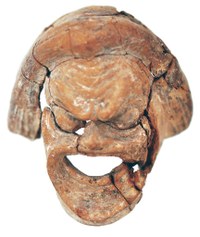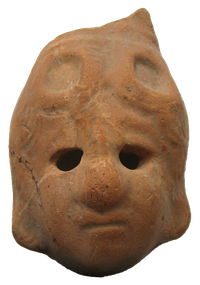Masks
 |
 |
The term mask entered the German language via the French and Italian forms (masque, masca) of the Arabic word maskharat and means fool, farce, joke. The now ubiquitous term mascara also comes from the same source and means nothing other than foolishness or farce.
The product of the ancient or later craft called "mask" is defined as a face separated vertically from the head, which is shown to be artificial by its rigid expression, exaggerated facial expressions and unnatural features. In contrast to protomes and busts, neither the neck nor the upper body are indicated in masks. The chin or the end of the beard form the lower end.
The Giessen Collection of Classical Antiquities includes two masks from different times and different contexts, that of the "leading slave" from New Attic comedy, Inv. T I-19, and a female miniature mask from the Roman north-western provinces, Inv. T II-2.
[1] L. Summerer, Masken, in dies., Hellenistische Terrakotten aus Amisos (Stuttgart 1999) 65-82.
